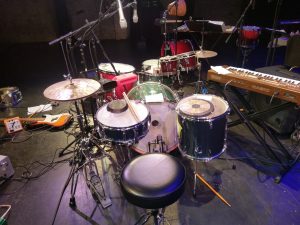Do Make Say Think is a Canadian band formed in the mid-nineties that is often classified as “post-rock” (nearly as imprecise a term as “post-modern”). The band’s cult following, however, recognizes their music for its unique blend of experimental rock and jazz fusion. Their extensive discography, which includes seven LPs and two EPs, showcases a multitude of different styles and influences; from classical to acoustic folk, sporadic jamming to tight, disciplined orchestral arrangements, and drone-like minimalism to magnificent atmospheres and ambient electronica.
I would like to focus on their sixth album and a personal favorite, Other Truths. The album, released in 2009, is comprised of a meager four tracks (although lengthy when compared to the music of their contemporaries ) and runs a little over forty minutes. Each track is titled after a word in the band’s name; which they originally co-opted from a row of motivational posters in an Elementary School. Produced by Do Make Say Think themselves and recorded in a member’s basement, Other Truths is, in my humble opinion, the band in its most distilled form.
“Do” begins with a bright, upbeat electric guitar riff that sounds as if it was lifted off an early-2000s pop-punk album. After guitar successfully establishes the song’s theme, the bass seizes the melody and plays a short solo before the rhythm loosens, the drums begin to syncopate, and a repetitive theme of descending guitar and vocal tones is layered over. Toward the middle of the track,the theme from the beginning is reintroduced and slowly built up until it is a dense wall of distortion and sound. Eventually, it fades and disappears into a contemplative mix of synths and church-like bells; a hypnotizing reinvention of the guitar theme. The tempo slows and the sound diminishes until nearly nothing is left, leaving the listener (or at least, this listener) with a paradoxical and almost hallucinatory feeling of euphoria and emptiness.
“Make” starts off with sparse and repetitive electric guitar mingling with a jazz/swing drum pattern. With the addition of a few unusual-sounding instruments (and at least one violin), the track slowly builds and crescendos. There is a gentle change into tribal-sounding drumming and a powerfully narrative guitar part before the introduction of echoing, darkly religious-sounding chants (there are lyrics available online; I personally do not hear all of them in the track). As the song progresses, it seems as if it will continue to descend into darkness. But a triumphant and almost defiant trumpet cuts through the darkness and the track takes another turn. To me, the tension between the distorted guitars, screeching violin, and the optimistic horns creates a beautiful drama that evokes a battle between good and evil. Perhaps the darkness wins, because the track’s apparent resolution comes amidst loud, distorted, and frenzied guitars. However, the piece continues with warm horns playing an ambiguous outro.
With its jazz drum beat, slide guitar, and distinctly-flavored chords, “Say” is the track in which Do Make Say Think’s jazz influence can be most clearly heard. Although without words, the track seems to follow a verse-chorus structure; the verse a simple, repetitive piano melody, augmented by a trailing guitar part and a prominent trumpet arpeggio, and the chorus an exuberant unison between guitar and trumpet. The softer, minor-key bridge features the guitar, but does not last long, and gives way to a return of the chorus. Following this last chorus, the rhythm slows into a folksy/blues outro in triple meter, with muted horns conversing with fuzzed vocals. Finally, everything gently comes to a rest; a peaceful end to an overall comforting track. To me, “Say” is the most hopeful piece of the album; brimming with certainty and optimism.
If there is a track on Other Truths that truly suits its name, it is “Think.” Introspective and spacious, “Think” really does make the listener do just that. Twanging, reverberating guitars exercise thoughtful restraint in a cyclical pattern, and soft vocal “oohs” float above a lightly brushed drum beat. Steady, stable, and never really going anywhere, “Think” is the perfect portrait of a lonely soul wandering through the unknown.
In its entirety, Other Truths is a beautiful journey for the listener; it is powerful but never excessive, sentimental yet never self-indulgent, and most importantly, it is resonant with the emotional whirlwind that is life.




